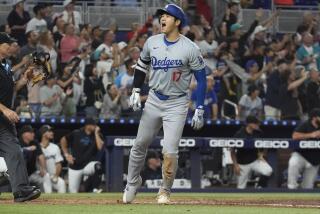‘Power, Energy’ of Japan Art Market Forecast
- Share via
NEW YORK — The multimillion-dollar artworks snapped up by Japanese collectors at highly publicized auctions are only “a tiny, tiny portion of the iceberg” in the Japanese art market, Ikkan Sanada told his audience at the 1989 Artnews World Art Market Conference.
A two-day meeting this week at the Grand Hyatt Hotel in Manhattan offered about 300 participants a tightly packed program on market-related topics ranging from business tips for dealers to “untapped potentials” for collectors.
“Inside the Japanese Art Market” was the subject addressed late Thursday afternoon by Sanada, director of Ikkan Art International Inc., a Japanese art advisory service in Manhattan. After detailing a “dramatic explosion” in Japanese art buying, he and fellow panelist Cynthia Gibbons, president of Art Placement International, had dealers standing in line for advice on how to get a piece of the action.
Record-setting sales of Van Gogh’s “Sunflowers” ($39.9 million), Picasso’s “Acrobat and Young Harlequin” ($38.5 million), Renoir’s “Young Girl Carrying a Basket of Flowers” ($5.3 million) and Pollock’s “Search” ($4.8 million) make headlines, Sanada conceded, but “the power and energy of the Japanese art market” are collectors who buy works priced from $100,000 to $1 million. And that power is growing.
Japan in 1988 imported $1.5 billion worth of art, a 400% increase from the previous year, he said. The nation of about 123 million has 600 public and private art museums. Sixty-three of them were built just last year and 50 or 60 more will open this year.
Eager dealers learned that the Japanese market is tough to enter, however. One needs a Japanese agent to approach museums or companies, and it’s almost impossible to introduce unknown artists in Japan. The Japanese tend to buy art “because it is well-known,” Sanada said.
While the high price of French Impressionism has caused Japanese collectors to diversify, particularly into American contemporary art, buyers look for credentials, such as museum shows and catalogues, that emerging artists don’t have.
Such established figures as Frank Stella, Jim Dine, Robert Longo and Julian Schnabel are “as far as they will go” into current art, he said. Japanese collectors “feel very comfortable with the ‘50s and ‘60s--Warhol, Johns and Lichtenstein. But work from the ‘70s and ‘80s is too risky and art leading into the ‘90s is almost impossible” to sell in Japan.
Another problem for dealers is that the new museums that easily secure funds for buildings and inaugural collections are typically stuck with woefully inadequate acquisitions budgets. The National Museum of Modern Art in Tokyo, for example, which is among “the most fortunate” Japanese museums, has an annual acquisitions budget of $750,000, Sanada said.
This is partly responsible for what he described as a “chaotic” situation in which new museums try to specialize in some aspect of art that avoids competition with other Japanese institutions, he said. A new museum in Fukuyama collects only Italian contemporary art, one in Tokyo concentrates on international prints and another in Kawasaki restricts itself to multiples--photographs, prints and posters.
Corporate collecting and support of cultural programs is just beginning to catch on. Japanese department stores, on the other hand, have a long tradition of exhibiting and selling first-rate art. Though their prices are high, people are willing to pay “because they trust the name of the department store,” Sanada said.
More to Read
The biggest entertainment stories
Get our big stories about Hollywood, film, television, music, arts, culture and more right in your inbox as soon as they publish.
You may occasionally receive promotional content from the Los Angeles Times.










